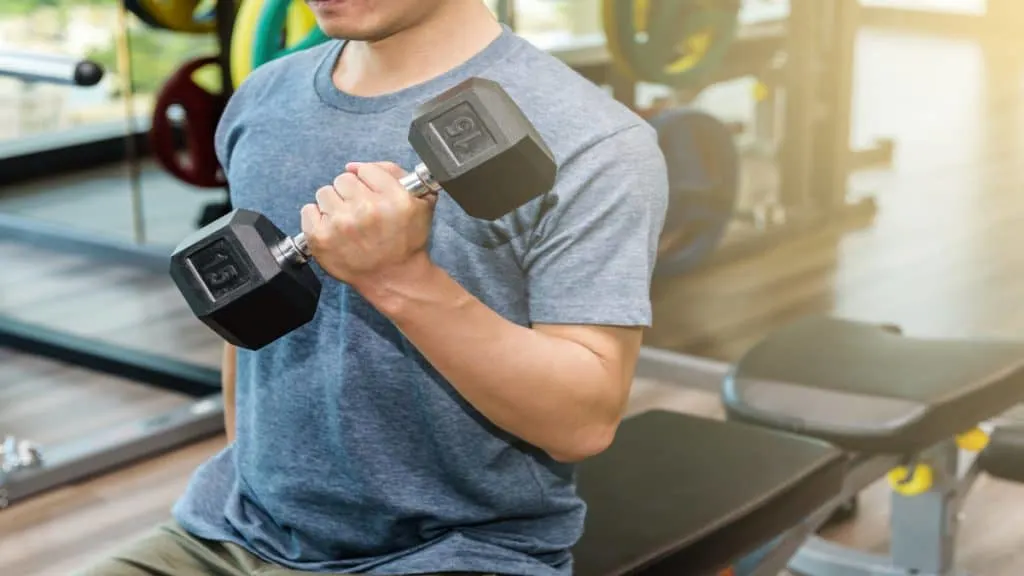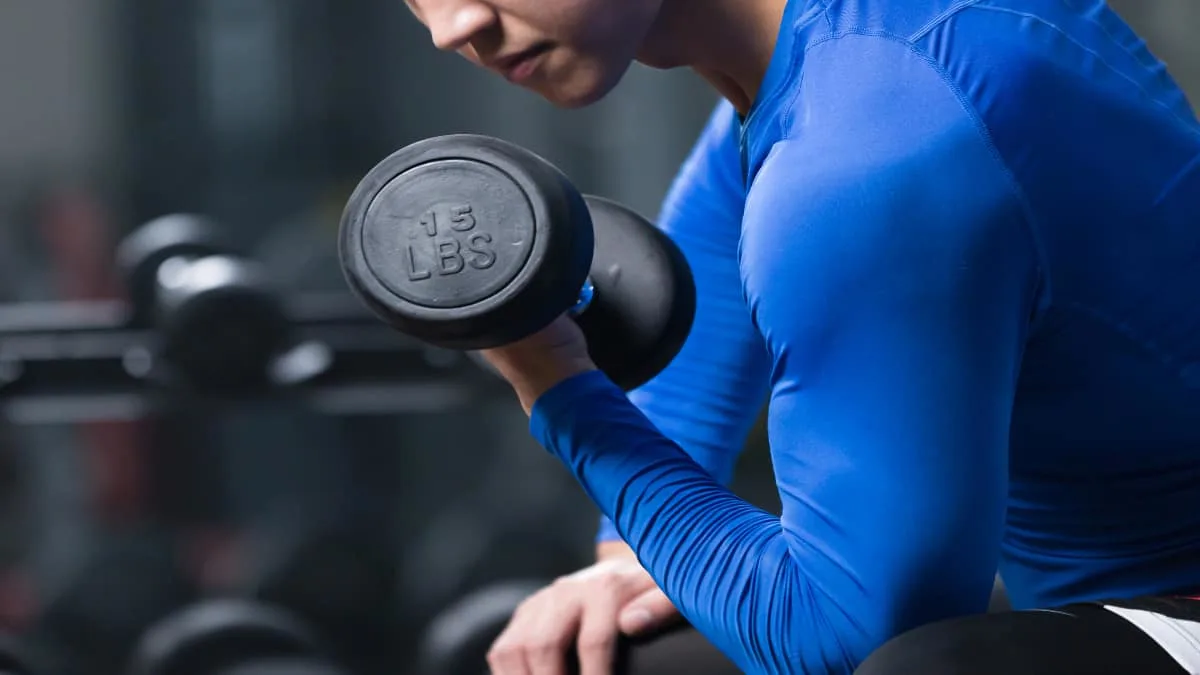How much can the average man curl? Is curling 15 pound dumbbells enough to build your biceps?
If you’ve ever pondered these questions before, then this article is for you.
You’ll learn if 15 lb dumbbell curls are enough to develop the biceps brachii musculature.
Additionally, we’ll explain how to use various intensity techniques to make 15 pound dumbbells even more challenging for your biceps.
See How Your Bicep Curl Compares:
Is curling 15 pounds good or not?

Although most gym-going men can curl more than 15 pounds, a 15 lb bicep curl is still a good lift if you’re using really strict form and doing plenty of reps and sets.
On the other hand, if you’re just lifting 15 lb weights without paying attention to your biceps, then you’re unlikely to see any progress.
However, if you use a full range of motion and really squeeze your biceps on every rep, then you can experience good bicep gains from lifting 15 lbs in each hand.
Similarly, if you just let the weights drop after lifting them, then your biceps won’t receive much tension (tension, not weight, is what builds muscle). Conversely, if you lower the dumbbells in a slow and controlled manner, then your biceps will really burn and get a great muscle growth stimulus as well.
15 lb bicep curl case studies
These 15 lb bicep curl case studies will give you some ideas on how to make your curls more challenging for your biceps.
Case study 1: Robin Achoe Jr
Robin Achoe Jr posted a video of himself doing 15 pound dumbbells curls for 2 sets of 50 reps (that’s 25 reps per arm on each set).
This fella clearly has good bicep development, so it just goes to show that you don’t need to lift the heaviest weights in the gym as long as your lifting technique is good (and his technique certainly was).
Unlike other lifters, Robin didn’t use momentum to swing the weights up. He did all of the heavy lifting with his biceps and he has some good results to show for it.
It looked like he could’ve done even more reps, especially on his first set. Perhaps he was just trying to get a pump, but when you’re training to maximize muscle hypertrophy, it’s crucial to train close to failure if you want to optimize your results. [1]
Case study 2: Z_Gaming
The man behind the YouTube channel Z_Gaming posted a video of himself doing 15 lb hammer curls. You could tell that the weights were really light for him because he was lifting the dumbbells together and in a “pumping” fashion.
In this scenario, it’s essential to do plenty of reps and sets (let’s say 3 sets of 30) so that you give your biceps enough time under meaningful tension.
Stopping 8 reps away from failure on a high rep set isn’t meaningful tension.
However, if you push yourself and stop 1-3 reps shy of failure, then you can experience really good bicep growth with very light weights. [2]
Case study 3: Syed Mohammad Shabbir
Syed Mohammad Shabbir posted a video of himself curling 15 pounds for reps.
His case study is interesting for a few reasons.
One, he shows that you don’t just have to do standing curls all the time. Bracing your arm against your leg can make it easier to achieve an intense peak contraction in your biceps.
Two, his example shows that using a full range of motion is very important, which is something that he didn’t do.
Although he might have got a good workout, his biceps would’ve received even better stimulation if he’d lifted the dumbbell further up and then lowered it until his elbow was fully locked out. To do this properly, he’d have needed to use a bench so that the dumbbell wouldn’t hit the floor.
How to make 15 pound curls harder

If you can only curl 15 pounds or only have access to 15 lb dumbbells, you can make your workouts even more challenging by trying the following intensity techniques.
First off, you can start with the hardest type of curl (reverse curl) and perform as many reps as possible. After you reach failure with a reverse grip, move straight into the next hardest curl variation (bicep curl) and rep that out until failure. Finally, finish the set with hammer curls, which are the easiest bicep curl that you can do.
Another option is to slow down your reps during the lowering phase of the rep. You should always lift weights explosively, but there’s no harm in performing slow-negatives in order to challenge your biceps with more time under tension.
Tension, if you remember, is what leads to muscle growth. Weight (or, more accurately, weight x reps x sets, which = training volume) is simply a convenient way to measure the tension that you’re putting your biceps under.
You can also perform prolonged isometrics whereby you hold the contraction for 3-5 seconds on each rep. This will get you used to contracting your biceps forcefully while giving you a more potent muscle pump in the process.
Related: Is curling 30 pounds good?
Conclusion: Who should be curling 15 pound dumbbells?
If you implement some of the above training techniques, then curling 15 pounds is actually plenty of weight to build some very well-developed biceps.
While 15 pounds might not be enough for a bodybuilder, it’s plenty of resistance for the average weight lifter to build their biceps.
Remember, there’s no rule that says 15 lb curls have to feel like 15 lb curls. You can make the same weight more challenging by slowing down your reps, holding the contraction, and training closer to failure.
15 pound dumbbell curls are enough for most people to see results when they use the proper technique because the biceps are a relatively small muscle group that doesn’t need all that much resistance to grow.
References
- Beardsley, C. (2021, December 7). How does proximity to failure affect hypertrophy? – Chris Beardsley. Medium. https://sandcresearch.medium.com/how-does-proximity-to-failure-affect-hypertrophy-e39653d41e96
- Lasevicius, T., Schoenfeld, B. J., Silva-Batista, C., Barros, T. D. S., Aihara, A. Y., Brendon, H., Longo, A. R., Tricoli, V., Peres, B. D. A., & Teixeira, E. L. (2019). Muscle Failure Promotes Greater Muscle Hypertrophy in Low-Load but Not in High-Load Resistance Training. Journal of Strength and Conditioning Research, Publish Ahead of Print. https://doi.org/10.1519/jsc.0000000000003454

